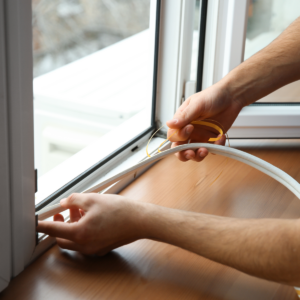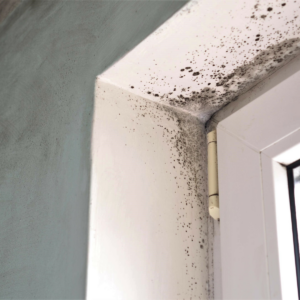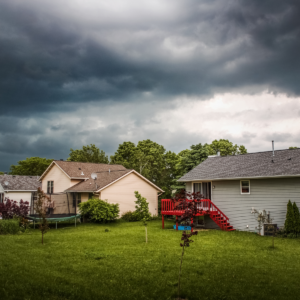Spring Storms: Protecting Your Home from Nature’s Fury
Spring is a season of renewal and growth but also brings its fair share of storms. As the temperatures rise and the weather becomes more unpredictable, it’s so important that your home is prepared to withstand the elements. Spring storms can significantly threaten your home’s integrity, from torrential rain and high winds to lightning and hail. This blog will guide you through the steps to prepare your home for spring storms, focusing on checking the integrity of doors and windows to prevent water damage and mold growth.
Assess the Vulnerability of Your Home
 Before diving into storm preparations, assess your home’s vulnerability to potential damage. Here are some factors to consider:
Before diving into storm preparations, assess your home’s vulnerability to potential damage. Here are some factors to consider:
- Age and condition of the roof: An older roof or one with damaged shingles is more susceptible to leaks and water damage during a storm.
- Integrity of doors and windows: Weak or improperly sealed doors and windows can allow water to seep into your home, leading to water damage and mold growth.
- Drainage system around the house: Poor drainage can result in water pooling around your home’s foundation, increasing the risk of flooding and water damage.
- Landscape and trees near the house: Overhanging branches and trees close to your home can pose a threat of damage from falling branches during a storm.
Tips for Preparing Your Home for Spring Storms
 Tip #1: Inspect and Reinforce Doors and Windows
Tip #1: Inspect and Reinforce Doors and Windows
- Check Seals and Weather Stripping: Seals and weather stripping can deteriorate over time, leading to drafts and water leaks. Inspect the seals around doors and windows and replace damaged or worn-out weather stripping. For example, if you notice gaps around your windows or doors when closed, it’s a sign that the weather stripping needs to be replaced.
- Secure Windows and Doors: Make sure that all windows and doors are securely latched to prevent them from being blown open by strong winds. Consider installing storm shutters or plywood covers for additional protection. For instance, installing storm shutters can protect against flying debris during a storm.
- Inspect for Leaks: Check for any signs of water damage around doors and windows, such as discoloration or mold growth. Repair any leaks promptly to prevent further damage. If you find any water stains or mold growth around your windows or doors, address the issue immediately to prevent mold from spreading.
What should I do if I find water damage or mold growth in my home?
 Discovering water damage or mold growth in your home can be concerning, but taking immediate action is essential to prevent further damage and health risks. Here’s what you should do if you find water damage or mold growth in your home:
Discovering water damage or mold growth in your home can be concerning, but taking immediate action is essential to prevent further damage and health risks. Here’s what you should do if you find water damage or mold growth in your home:
- Identify the Source of the Water: First, identify and stop the water source to prevent further damage. This could be a leaky roof, a burst pipe, or flooding from a storm. If the water damage is due to a plumbing issue, turn off the water supply to the affected area.
- Remove Standing Water: If standing water is in your home, remove it quickly to prevent further damage and mold growth. Use a wet/dry vacuum to remove the water, and consider using fans and dehumidifiers to dry out the affected area.
- Clean and Disinfect the Area: Thoroughly clean and disinfect the area to remove mold and prevent it from spreading. Wear protective gear, such as gloves and a mask, to avoid exposure to mold spores. Use a solution of water and detergent to clean the affected area, and then apply a disinfectant to kill any remaining mold spores.
- Repair the Damage: After cleaning and disinfecting the area, repair any damage caused by the water to prevent future issues. This may include replacing damaged drywall, insulation, or flooring.
- Address the Underlying Issue: Finally, address the underlying issue that caused the water damage to prevent future problems. This may involve repairing a leaky roof, fixing a burst pipe, or improving the drainage around your home to prevent flooding.
While a homeowner could attempt to remedy a water damage problem or assess it on their own, calling the team at AMD Environmental is best for several reasons. Our experts have the knowledge, experience, and equipment to accurately assess the extent of the damage, identify the underlying causes, and provide effective solutions to mitigate the damage and prevent future issues.
Tip #2: Maintain Your Roof
- Inspect for Damage: Regularly inspect your roof for any signs of damage, such as missing or damaged shingles. Replace any worn-out or damaged shingles to prevent water leaks during a storm. For example, if you notice any cracked or curled shingles on your roof, it’s a clear indication that they need to be replaced to maintain the integrity of your roof.
- Clean Gutters and Downspouts: Clear out debris from gutters and downspouts to ensure proper drainage. Clogged gutters can cause water to back up and seep into your home, leading to water damage and mold growth. If your gutters are filled with leaves, twigs, or other debris, cleaning them out is important to prevent water from overflowing and damaging your home’s foundation.
How often should I inspect my roof for damage?
 Regular roof inspections are essential to identify and address any potential issues before they become significant problems. Here’s how often you should inspect your roof for damage:
Regular roof inspections are essential to identify and address any potential issues before they become significant problems. Here’s how often you should inspect your roof for damage:
- Twice a Year: Inspect your roof at least twice a year, ideally in the spring and fall, to check for any signs of damage or wear and tear. Look for missing or damaged shingles, cracked or curled shingles, and any signs of water damage or mold growth.
- After Severe Weather: After severe weather, such as a storm with high winds or hail, inspect your roof for any signs of damage. Strong winds can loosen or remove shingles, and hail can cause dents and cracks in the shingles.
- Before and After Winter: Before winter, inspect your roof to ensure it’s in good condition and ready to withstand the colder temperatures, snow, and ice. After winter, inspect your roof again to check for any damage caused by the harsh winter weather.
Tip #3: Secure Outdoor Furniture and Décor
- Anchor or Store Items: Secure or store outdoor furniture, grills, and décor to prevent them from being picked up by strong winds and causing damage to your home or neighboring properties. For instance, if you have patio furniture, consider anchoring it down or storing it securely to prevent it from being blown away during a storm.
- Trim Trees and Shrubs: Remove Dead or Weak Branches: Prune trees and shrubs to remove any dead or weak branches that could break off and damage your home during a storm. For example, if you notice any dead or overhanging branches near your home, it’s essential to trim them to reduce the risk of them falling and causing damage during a storm.
Tip #4: Create an Emergency Preparedness Kit
- Gather Essential Supplies: Assemble an emergency preparedness kit with essential supplies such as flashlights, batteries, first aid supplies, bottled water, non-perishable food, and a battery-powered radio. For instance, a basic emergency kit should include enough supplies for each household member to last at least three days.
- Develop a Family Emergency Plan: Create a family emergency plan with evacuation routes, a designated meeting place, and emergency contact information. Discuss the plan with your family and ensure everyone knows what to do in a severe storm or other emergency.
What should I do if a storm is approaching and I still need to prepare my home?
 If a storm is approaching and you haven’t prepared your home yet, don’t panic. You can still take steps to minimize potential damage and keep your home and family safe. Here’s what you should do:
If a storm is approaching and you haven’t prepared your home yet, don’t panic. You can still take steps to minimize potential damage and keep your home and family safe. Here’s what you should do:
- Secure Outdoor Items: Quickly secure or store outdoor furniture, grills, and décor to prevent them from being picked up by strong winds and damaging your home or neighboring properties.
- Reinforce Doors and Windows: Check that all windows and doors are securely latched to prevent them from blowing open by strong winds. Consider installing storm shutters or plywood covers for additional protection.
- Check Seals and Weather Stripping: Inspect the seals around doors and windows and replace any damaged or worn-out weather stripping. If you notice gaps around your windows or doors when closed, it’s a sign that the weather stripping needs to be replaced.
Tip #5: Monitor Weather Alerts and Stay Informed
- Stay Updated on Weather Conditions: Monitor local weather forecasts and stay informed about any severe weather alerts or warnings in your area. Sign up for weather alerts on your smartphone or through local news sources. For example, downloading a weather app on your smartphone can help you stay updated on your area’s weather conditions and alerts.
Get Ready! Stay Ready!
Preparing your home for spring storms is essential to protect your property and belongings from potential damage. Early preparation is key to minimizing the risk of water damage and mold growth, ensuring your home remains a safe and secure haven during stormy weather.

